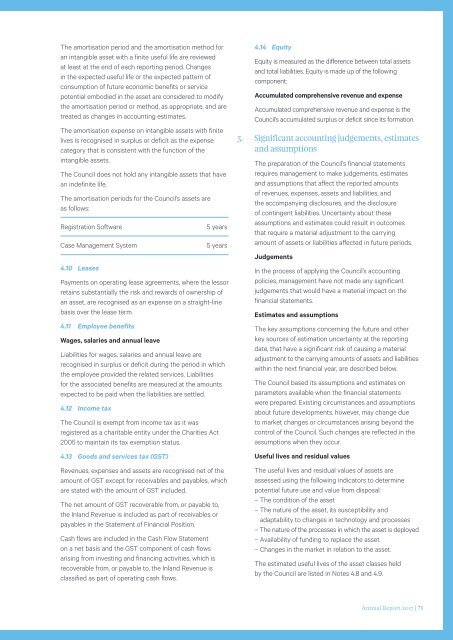NZNA_AnnualReport2017_280817_v10_small
Create successful ePaper yourself
Turn your PDF publications into a flip-book with our unique Google optimized e-Paper software.
The amortisation period and the amortisation method for<br />
an intangible asset with a finite useful life are reviewed<br />
at least at the end of each reporting period. Changes<br />
in the expected useful life or the expected pattern of<br />
consumption of future economic benefits or service<br />
potential embodied in the asset are considered to modify<br />
the amortisation period or method, as appropriate, and are<br />
treated as changes in accounting estimates.<br />
The amortisation expense on intangible assets with finite<br />
lives is recognised in surplus or deficit as the expense<br />
category that is consistent with the function of the<br />
intangible assets.<br />
The Council does not hold any intangible assets that have<br />
an indefinite life.<br />
The amortisation periods for the Council’s assets are<br />
as follows:<br />
Registration Software<br />
Case Management System<br />
4.10 Leases<br />
5 years<br />
5 years<br />
Payments on operating lease agreements, where the lessor<br />
retains substantially the risk and rewards of ownership of<br />
an asset, are recognised as an expense on a straight-line<br />
basis over the lease term.<br />
4.11 Employee benefits<br />
Wages, salaries and annual leave<br />
Liabilities for wages, salaries and annual leave are<br />
recognised in surplus or deficit during the period in which<br />
the employee provided the related services. Liabilities<br />
for the associated benefits are measured at the amounts<br />
expected to be paid when the liabilities are settled.<br />
4.12 Income tax<br />
The Council is exempt from income tax as it was<br />
registered as a charitable entity under the Charities Act<br />
2005 to maintain its tax exemption status.<br />
4.13 Goods and services tax (GST)<br />
Revenues, expenses and assets are recognised net of the<br />
amount of GST except for receivables and payables, which<br />
are stated with the amount of GST included.<br />
The net amount of GST recoverable from, or payable to,<br />
the Inland Revenue is included as part of receivables or<br />
payables in the Statement of Financial Position.<br />
Cash flows are included in the Cash Flow Statement<br />
on a net basis and the GST component of cash flows<br />
arising from investing and financing activities, which is<br />
recoverable from, or payable to, the Inland Revenue is<br />
classified as part of operating cash flows.<br />
4.14 Equity<br />
Equity is measured as the difference between total assets<br />
and total liabilities. Equity is made up of the following<br />
component:<br />
Accumulated comprehensive revenue and expense<br />
Accumulated comprehensive revenue and expense is the<br />
Council’s accumulated surplus or deficit since its formation.<br />
5. Significant accounting judgements, estimates<br />
and assumptions<br />
The preparation of the Council’s financial statements<br />
requires management to make judgements, estimates<br />
and assumptions that affect the reported amounts<br />
of revenues, expenses, assets and liabilities, and<br />
the accompanying disclosures, and the disclosure<br />
of contingent liabilities. Uncertainty about these<br />
assumptions and estimates could result in outcomes<br />
that require a material adjustment to the carrying<br />
amount of assets or liabilities affected in future periods.<br />
Judgements<br />
In the process of applying the Council’s accounting<br />
policies, management have not made any significant<br />
judgements that would have a material impact on the<br />
financial statements.<br />
Estimates and assumptions<br />
The key assumptions concerning the future and other<br />
key sources of estimation uncertainty at the reporting<br />
date, that have a significant risk of causing a material<br />
adjustment to the carrying amounts of assets and liabilities<br />
within the next financial year, are described below.<br />
The Council based its assumptions and estimates on<br />
parameters available when the financial statements<br />
were prepared. Existing circumstances and assumptions<br />
about future developments, however, may change due<br />
to market changes or circumstances arising beyond the<br />
control of the Council. Such changes are reflected in the<br />
assumptions when they occur.<br />
Useful lives and residual values<br />
The useful lives and residual values of assets are<br />
assessed using the following indicators to determine<br />
potential future use and value from disposal:<br />
– The condition of the asset<br />
– The nature of the asset, its susceptibility and<br />
adaptability to changes in technology and processes<br />
– The nature of the processes in which the asset is deployed<br />
– Availability of funding to replace the asset<br />
– Changes in the market in relation to the asset.<br />
The estimated useful lives of the asset classes held<br />
by the Council are listed in Notes 4.8 and 4.9.<br />
Annual Report 2017 | 73


